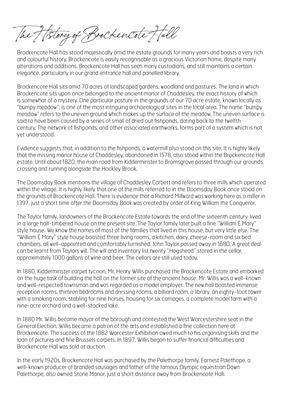
The History of Brockencote Hall
Brockencote Hall has stood majestically amid the estate grounds for many years and boasts a very rich
and colourful history. Brockencote is easily recognisable as a gracious Victorian home, despite many
alterations and additions. Brockencote Hall has seen many custodians, and still maintains a certain
elegance, particularly in our grand entrance hall and panelled library.
Brockencote Hall sits amid 70 acres of landscaped gardens, woodland and pastures. The land in which
Brockencote sits upon once belonged to the ancient manor of Chaddesley, the exact history of which
is somewhat of a mystery. One particular pasture in the grounds of our 70 acre estate, known locally as
"bumpy meadow", is one of the most intriguing archaeological sites in the local area. The name "bumpy
meadow" refers to the uneven ground which makes up the surface of the meadow. The uneven surface is
said to have been caused by a series of small of dried out fishponds, dating back to the twelfth
century. The network of fishponds, and other associated earthworks, forms part of a system which is not
yet understood.
Evidence suggests that, in addition to the fishponds, a watermill also stood on this site. It is highly likely
that the missing manor house of Chaddesley, abandoned in 1578, also stood within the Brockencote Hall
estate. Until about 1820, the main road from Kidderminster to Bromsgrove passed through our grounds,
crossing and running alongside the Hockley Brook.
The Doomsday Book mentions the village of Chaddesley Corbett and refers to three mills which operated
within the village. It is highly likely that one of the mills referred to in the Doomsday Book once stood on
the grounds of Brockencote Hall. There is evidence that a Richard Millward was working here as a miller in
1397, just a short time after the Doomsday Book was created by order of King William the Conqueror.
The Taylor family, landowners of the Brockencote Estate towards the end of the sixteenth century, lived
in a large half-timbered house on the present site. The Taylor family later built a fine "William & Mary"
style house. We know the names of most of the families that lived in this house, but very little else. The
"William & Mary" style house boasted three living rooms, a kitchen, dairy, cheese-room and six bed
chambers, all well-appointed and comfortably furnished. John Taylor passed away in 1680. A great deal
can be learnt from Taylors will. The will and inventory list twenty "Hogshead" stored in the cellar,
approximately 1000 gallons of wine and beer. The cellars are still used today.
In 1880, Kidderminster carpet tycoon, Mr. Henry Willis purchased the Brockencote Estate and embarked
on the huge task of building the hall on the former site of the ancient house. Mr. Willis was a well-known
and well-respected townsman and was regarded as a model employer. The new hall boasted immense
reception rooms, thirteen bedrooms and dressing rooms, a billiard room, a library, an eighty-foot tower
with a smoking room, stabling for nine horses, housing for six carriages, a complete model farm with a
nine-acre orchard and a well-stocked lake.
In 1880 Mr. Willis became mayor of the borough and contested the West Worcestershire seat in the
General Election. Willis became a patron of the arts and established a fine collection here at
Brockencote. The success of the 1882 Worcester Exhibition owed much to his organising skills and the
loan of pictures and fine Brussels carpets. In 1897, Willis began to suffer financial difficulties and
Brockencote Hall was sold at auction.
In the early 1920s, Brockencote Hall was purchased by the Palethorpe family. Earnest Palethope, a
well-known producer of branded sausages and father of the famous Olympic equestrian Dawn
Palethorpe, also owned Stone Manor, just a short distance away from Brockencote Hall.